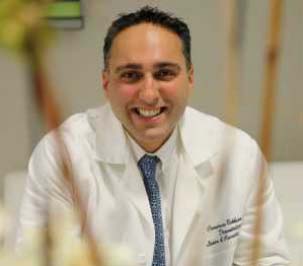Basal Cell Carcinoma Surgery in New York
What is basal cell carcinoma?
Basal cell carcinoma (BCC) is the most common type of cancer in the United States. BCC is a cancer of the skin caused by ultraviolet (UV) light exposure. BCC begins in the deepest layer of the epidermis of the skin: the basal layer. BCC typically occurs in areas that are exposed to the sun, such as the head, face, and neck, but it can occur in any area of the body.
BCC is a slow-growing cancer that rarely metastasizes. Even so, BCC can be very damaging. If left untreated, BCC will continue to grow and will invade and destroy the surrounding skin and tissues beneath the skin.
The major risk factor for BCC is UV light exposure, whether from the sun or tanning beds. Although anyone can develop BCC, people with certain physical characteristics (such as light or freckled skin, light eyes or hair, or difficulty getting a tan) are at increased risk. Other risk factors include taking immunosuppressant medications, overexposure to X-rays, having a close relative who had a BCC growth, or previously having had a BCC growth.
What does BCC look like?
Generally, a BCC growth looks like a pink or pearly white lesion or sore. BCC lesions commonly bleed easily, crust over, and heal poorly. There may be tiny blood vessels on the lesion (called ‘telangiectasias’), or the lesion may have a center that appears depressed (like a pie that deflated in the middle).
Some BCC subtypes have special characteristics. For example, BCC can also appear as any of the following:
- A dome-shaped, nodular lesion with the same pearly white/pink color as described above. Growths of this type of lesion are frequently irregular (i.e., some parts of the lesion grow larger than others). This type of lesion may also have areas of black or brown pigment.
- A flat growth that is round- or oval-shaped, with crusty red scales. This subtype may be mistaken for eczema or psoriasis.
- A lesion that looks like a scar, is pale whitish-yellow and feels waxy to the touch.
The one and the only way to diagnose any type of skin cancer is to biopsy the skin. Skin biopsy is a simple procedure in which part of the lesion is removed and examined under a microscope to detect any cancerous cells.
Treatment for BCC
The method of treatment for BCC depends on many factors, including the subtype and location of the BCC growth. Methods of treatment include the following:
- Cryotherapy: Liquid nitrogen is used to freeze and kill the cancerous cells.
- Curettage: Dr. Rokhsar uses a tool to scoop out the cancerous growth, then applies an electrical current to the area to ensure destruction of any remaining cancerous cells.

- Excision: The doctor cuts out the lesion and some normal skin around the lesion, then examines the removed tissue to see if the normal skin around the lesion is free of cancerous cells. If the doctor finds abnormal cells, the procedure is repeated until the normal skin is free of cancerous cells under the microscope. The excision method is less desirable for BCCs on the face.

- Mohs micrographic surgery: Mohs is similar to the excision method in that the lesion is removed and examined under a microscope to ensure complete removal of the cancerous growth. However, as the name “micrographic” implies, during Mohs treatment, the doctor removes the growth in thin layers. The removed skin is “mapped” and processed in such a way that 100% of the lesion can be examined for abnormal cells. This method allows leaving as much normal skin as possible intact. Physicians licensed to perform Mohs surgery have had 1 year of extra training.

- Photodynamic therapy: The doctor applies a chemical to the skin and shines a light on the area to destroy the cancer cells.
- Radiation: Radiation treatment can be used for lesions in areas that would be difficult to treat surgically (for example, the eyelids).
- Nonsurgical therapy: Imiquimod (Aldara™) or 5-fluorouracil are creams that are applied directly to the BCC growth for removal. Non-surgical treatments can be used if BCC is recognized in the ear.
Dr. Rokhsar is a trained Mohs and cosmetic surgeon. As a fellowship-trained dermatologist surgeon, he specializes in Mohs Micrographic surgery which is the most precise way to remove skin cancer. Fellowship-trained doctors gain a significant amount of intensive training after they complete their bachelor’s degree, medical school requirements, residential training, and dermatology training. The additional training results in a level of expertise and knowledge beyond most dermatologists.
Basal Cell Carcinoma FAQ
How common is basal cell carcinoma?
Basal cell carcinoma (BCC) is the most common type of skin cancer, accounting for approximately 80% of all cases. BCC is usually caused by long-term sun exposure and typically occurs in older adults, although it can also affect younger adults. According to the American Cancer Society, an estimated 3.6 million Americans are diagnosed with BCC each year, and the number of reported cases in the US has been steadily increasing. BCC is rarely fatal, but it can be highly destructive and disfiguring if left untreated.
What are the risk factors for basal cell carcinoma?
There are several risk factors that increase the likelihood of developing BCC, including UV exposure, history of skin cancer (including squamous cell carcinoma or melanoma), fair skin, age over 50, male gender, and a tendency to freckle or burn easily. Other risk factors include radiation exposure from cancer treatment, exposure to industrial compounds, weakened immune system, and genetic factors such as nevoid basal cell carcinoma syndrome.
How to prevent basal cell carcinoma?
The best way to prevent basal cell carcinoma is by protecting your skin from UV radiation:
- Limit your sun exposure, especially during peak sun hours: Avoid being outside when the sun is strongest, typically between 10 a.m. and 4 p.m. If you must be outside during these hours, seek shade or wear protective clothing like long-sleeved shirts, pants, wide-brimmed hats, and sunglasses.
- Wear sunscreen: Apply a broad-spectrum sunscreen with an SPF of 30 or higher every day, regardless of the weather or season. Reapply every two hours if you’re outside or participating in activities like swimming.
- Avoid tanning beds: Tanning beds emit harmful UV radiation that can increase your risk of developing skin cancer, including basal cell carcinoma.
- Check your skin regularly: Perform self-examinations regularly to look for any changes in your skin, such as new growths or spots that have changed in size, shape, or color.
- Get regular skin cancer screenings: Schedule regular skin cancer screenings with a dermatologist, especially if you have a personal or family history of skin cancer or if you have fair skin, red or blonde hair, and blue or green eyes.
- Consider Mohs micrographic surgery: For individuals with a high risk of developing basal cell carcinoma, Mohs micrographic surgery can be an effective treatment option with high cure rates.
What does basal cell carcinoma look like?
It typically appears as a small, shiny, pink or red bump or growth that may have a raised, rolled edge and a crusted indentation in the center. BCC can also have a smooth surface or cause an open sore that does not heal, and it may be raised in some parts, sunken in some parts, or both. Some types of BCC may be soft and have a jelly-like texture and darker coloring. Additionally, BCC may have visible blood vessels on the surface and crust and bleed. BCC can vary in appearance and may be mistaken for other skin conditions such as a wart, mole, or pimple, but if you notice a spot or growth on your skin that is growing or changing in any way, it’s important to see a board-certified dermatologist for an evaluation.
How does basal cell carcinoma affect the body?
In most cases, basal cell carcinoma is not life-threatening and rarely spreads to other parts of the body. However, if left untreated, it can grow deeper into the skin and damage nearby tissues, including bones, nerves, and muscles. This can cause disfigurement and loss of function, particularly if it affects the face or other sensitive areas.
How long can you wait to treat basal cell carcinoma?
Basal cell carcinoma should be treated as soon as possible after diagnosis. BCC is a slow-growing form of skin cancer, and while it is rarely fatal, it can cause significant damage and disfigurement if left untreated. Waiting to treat BCC can also increase the likelihood of recurrence, as approximately 25% of people with a history of BCC develop a new lesion within 5 years of the first one.
The best treatment for BCC depends on the type, location, and size of cancer, as well as your preferences and ability to do follow-up visits. Options for treatment include Mohs surgery, excision, curettage, and electrodesiccation, and topical medications such as imiquimod and 5-fluorouracil. Dr. Cameron Rokhsar will work with you to determine the best treatment plan for your individual case. Dr. Rokhsar is a double board-certified Mohs dermatologic surgeon.
How long does it take to recover from basal cell carcinoma surgery?
For simple surgical procedures like excision or curettage and desiccation, healing may take just a few weeks. However, for more complex surgeries like Mohs micrographic surgery, which is considered the most thorough method for treating basal cell carcinoma, the procedure may take several hours or longer, and recovery may take longer, up to several months.
In general, the wound may take 3 to 6 weeks to heal, and the scar may fade with time if good wound care is provided. It’s essential to follow your doctor’s instructions carefully and avoid strenuous activities that may disrupt the wound’s healing process.
New York Office Locations
Upper East Side Manhattan Office
121 East 60th Street, Suite 8AB New York, NY 10022
(212) 285-1110
Long Island Office
901 Stewart Ave, Suite 240, Garden City, NY 11530
(516) 512-7616






 Dr. Rokhsar was chosen by
Dr. Rokhsar was chosen by 






